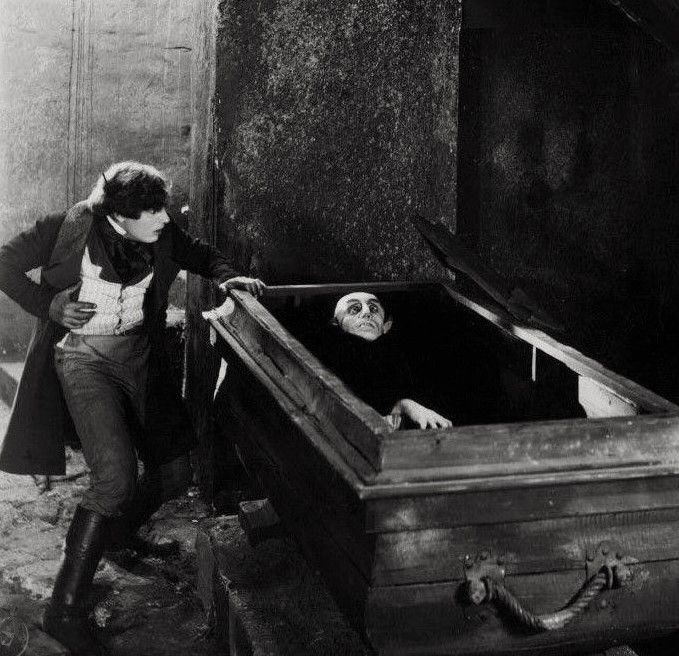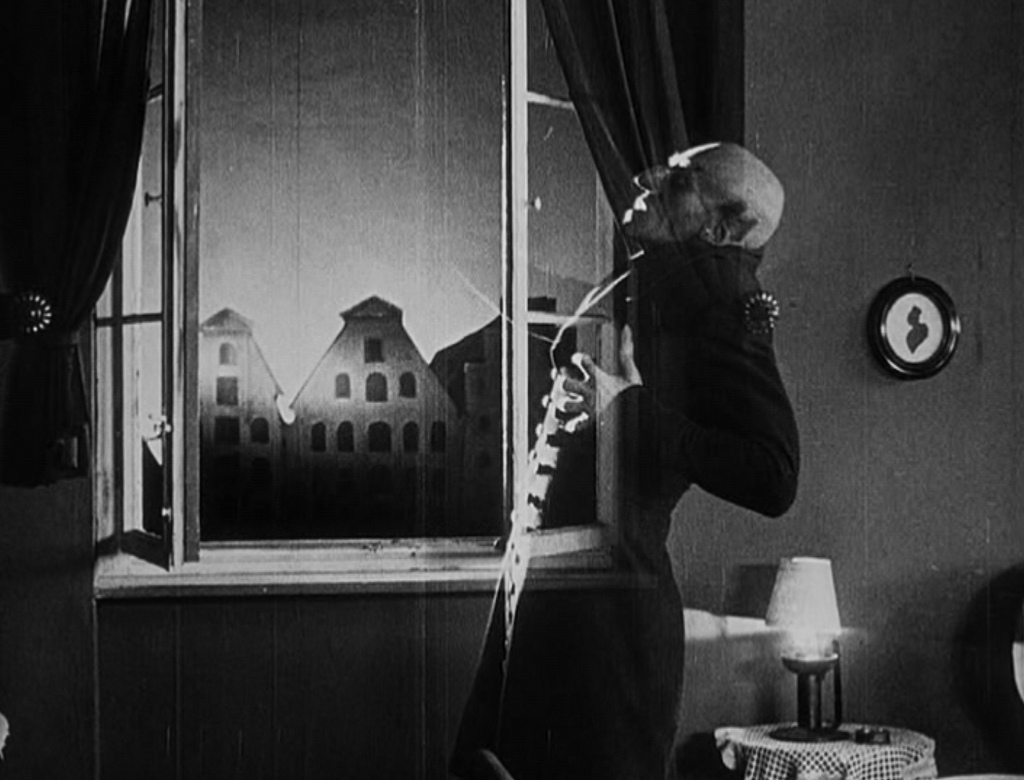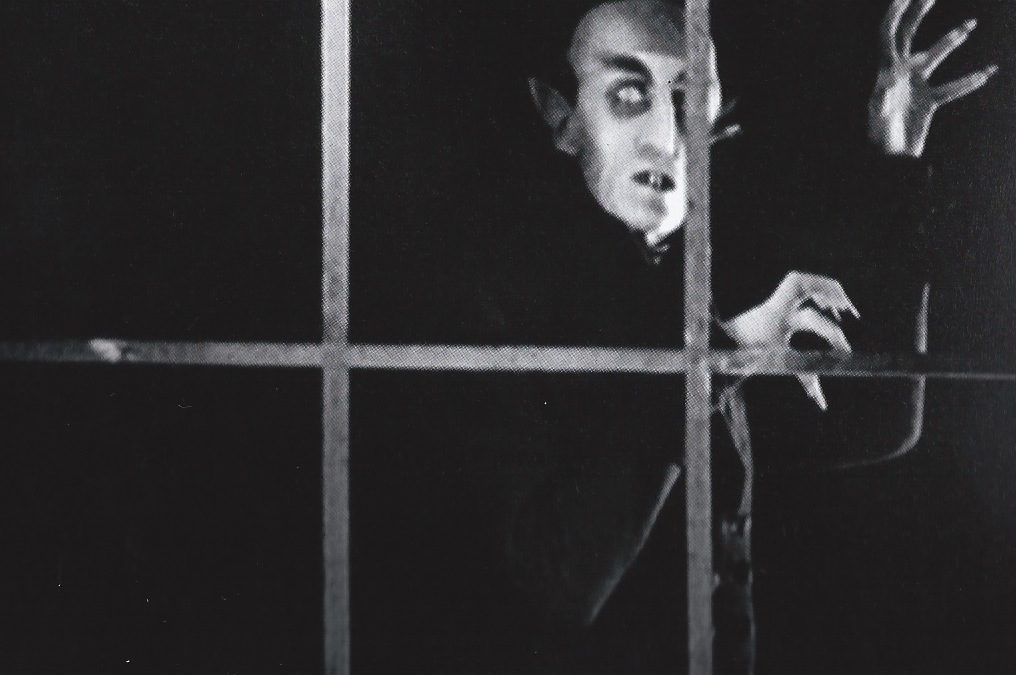Written by Victoria Osborn
Travel back in time with us. 100 years ago to be precise! A film debuted first in the Netherlands in February 1922, then later again in Germany in March of that same year. A film which would go on to be such a controversy that a fictional film was made about how it was made. The controversy regarding this silent German Expressionist horror film was not only because of the lawsuit about it, but because the vampire character seemed too real to be merely the talents of an actor and some speculated that he was in fact a real vampire. The fictional film “Shadow of the Vampire” came out in 2000.
In 1922, “Nosferatu” was produced by Prana Film. Prana Film made only this one film, then declared bankruptcy to avoid paying for the adaptation to Bram Stoker’s widow or maybe because of the costly lawsuit that went on for 3 years. Florence Balcombe (Bram’s widow) became aware of the production when someone sent her a program of the premiere that was already held at Berlin Zoological Garden. She did not even know of its existence prior to this and did not sell the rights to the German company. Not only was she extremely upset that they did this behind her back, but she really needed the money at the time.

In July 1925 she won the case against them and the ruling stated that all the negatives and all prints of the film should be handed over to her to be destroyed. Obviously, that did not happen. One sole copy of the film survived and was seen in the United States in 1929. If not for this single copy,not only would the movie have been completely lost to us, but many creative vampire stories that came after might not have even been made because ‘Nosferatu’ was the writer’s creative influence.
‘Nosferatu’ was directed by F. W. Murnau (who went on to direct ‘Sunrise: A Song of Two Humans’ in 1927 among many other films, some of which are now lost to us.) The screenplay was written by Henrik Galeen (‘The Student of Prague’; ‘Nosferatu the Vampyre’) . Galeen changed Count Dracula’s name to Count Orlok (Max Schreck {‘The Mayor of Zalamea’; ‘The Grand Duke’s Finances’}) among other small changes.
This film was thought to have changed the names to unsuccessfully avoid the obvious copyright infringement. However, it is possible that the changes were made because it is a German film with the settings to be in Germany, so changing the names would be appropriate to keep with the German settings. Either way, this film is a forbidden treasure that is worth the naughty peeks. Don’t you just feel naughty watching it? We did.

As stated earlier this classic film is a silent movie. There is something magical about a silent movie. Silent movies era ran from 1894-1929, however the German Expressionist horror film era was just in the 1920’s after the devastation of WW2. The extreme emotions portrayed in the German expressionist films were largely influenced by the war. While silent movies as a whole did tend to portray unnatural extreme emotions anyway, the German Expressionists were even more extreme. This tended to add to the flare of the silent movies, in both comical and horrifying ways. The way they portray the story without words, and a few sentences placed on a black screen to carry it along is a lost art now. Without the use of vocal dialog, a silent movie must rely heavily on the musical composure that would be live at the event to entertain. Going to any one of these events would have been spectacular. Oftentimes the audience was instructed to come in costume, as the premiere of ‘Nosferatu’ did. The invitation to the premiere asked that people arrive in “Biedermeier” costumes. The original musical score was composed by Hans Erdmann (‘Le testament du Dr. Mabuse/The Testament of Dr. Mabuse’ ; ‘Augustus the Strong’) has been lost. What we hear in the movie now is a partial adoption of the original long lostworks, and a multitude of other composers over time writing and playing their own soundtracks to go along with the film.
The music for Nosferatu does not disappoint, however at times it can be a bit of a distraction to the otherwise captivating film. There are times that the music itself seems to come alive as if it is a creature of the dark, then occasionally it is so distracting from the scene that muting it might be a wise choice. However, throughout the movie, it gives us hints into what will happen, has happened, or is happening. It would be interesting to hear the full original composure. How it originally fit with the story.

The story is in fact, a lot like Bram Stoker’s “Dracula”, with some differences, besides the names and place.
Thomas Hutter (Gustav von Wangenheim {‘Romeo and Juliet in the Snow’; ‘The Pilgrimage of Love’}) is tasked with a mission to sell the abandoned estate across the way from his home. His boss, Herr Knock (Alexander Granach {‘The Big Big Boss’; ‘So Ends Our Night’}) tells Hutter to sell it to Count Orlok. Later on we find out that Knock is devoted to Orlok, with a quick flash of the words “That patient who we brought in yesterday, has gone out of his mind”. We see him in a room looking possessed. Later, he is muttering “my master” and seems to know when Orlok has arrived and what Orlok is doing at any given time.
Hutter meets Count Orlok after a carriage is sent for him to pick him up where his previous carriage left him. They would not bring him any further because they were afraid. Strange things begin to happen almost immediately. While Hutter partakes in a meal, he accidently cuts his thumb causing Orlok to momentarily lose control and attempt to suck the blood from him. Next we see that he has woken up from the room he was taken to, and a letter he writes to his wife Ellen (Greta Schröder {‘Victoria the Great’; ‘Maria Theresa’}) describes that he is plagued by mosquitoes in fact 2 bites were on his neck. Ellen seems to have a psychic connection to her husband, and/or Count Orlok and is seen screaming her husband’s name to warn him of the threat while he is in his room.
After reading a book about vampires, Hutter begins to suspect that Orlok was indeed a vampire, but this came too late as Orlok has already signed the papers to take ownership of the building and already glimpsed Ellen. He only makes a hint of his attraction to her by saying she has a lovely neck, this is yet another difference from the Stoker version in which Dracula became very obsessed with Mina.

While Stoker’s version portrays Dracula making other vampires, Orlok does not. He comes bringing death that the townspeople mistake as a plague and this idea is made stronger when they encounter the rats that Orlok traveled with.
Throughout the movie there are many obvious parallels with Stoker’s Dracula that makes the lawsuit understandable and obvious to why it was lost. However, there are several spins to the story, little nuggets that a true Stoker fan would easily be able to see that were not the same.
Watch the movie to see the similarities, watch it to look for the subtle differences, or watch it for the pure entertainment it provides. Watch it, just make sure you cover that pretty neck.

